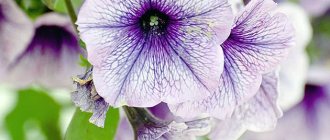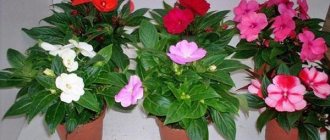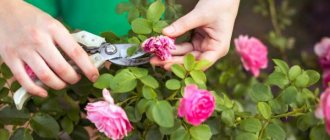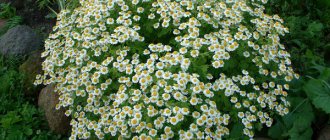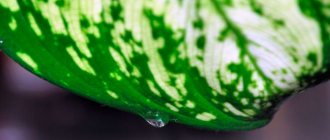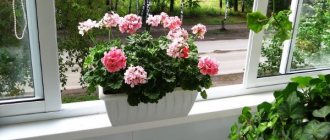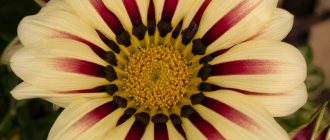2.Description - what petunia looks like
Petunias are beautiful perennial flowering herbaceous plants.
The stems are erect, hanging down in a stunning cascade in ampelous species.
The leaves are oval, sessile, 5 - 7 cm long.
The flowers are very large - up to 10 cm in diameter, funnel-shaped, with 5 fused petals, in a wide variety of colors, including two-tone ones. Currently, varieties with yellow flowers have been obtained. In many varieties, the flowers have a delicate, pleasant aroma, which intensifies at night. The buds form and open sequentially - from the base of the shoots to their tops.
Height . Depending on the variety, it ranges from 15 cm to 40 cm . In ampelous petunias, the shoot length reaches 60 - 70 cm .
Petunia in pots
Flower beds of blooming petunias look very beautiful. And how fragrant it begins to smell towards the evening! But few people know that such a miracle can be grown not only outdoors, but also at home as a houseplant. Do you want to decorate your balcony or windows with this beautiful flower? Then our advice will be useful to you.
How to grow petunia in a pot?
Petunia is an annual plant; in order for it to delight you every year, you will have to work a little. First you need to grow seedlings, and only after that you can plant petunias in pots.
It is best to start growing petunia seedlings in February. There will be just the right temperature and lighting, and there will be enough time for the plant to grow.
- Sprinkle petunia seeds onto flat, moist ground and sprinkle them a little from a spray bottle or a special small watering can. There is no need to cover them with earth; it will be enough to just put a light plank on them, thus ensuring better contact with the ground.
- Seeds require warmth, the most optimal temperature is 22-26°C. Cover your “bed” with film and place it in the sun near the radiator. By the way, experienced gardeners advise replacing the film with non-woven material, believing that this creates a more favorable atmosphere for the plants. What to choose - decide for yourself.
- When the seedlings begin to grow, you can remove their “blanket”. Now you need to make sure that the temperature in the room is no higher than 20°C.
- After you notice the first true leaves appearing, you can separate and replant the flowers in disposable cups. Some skip this step, and some immediately plant the seeds in disposable containers. Why is this necessary? If you plant the sprouts in transparent plastic cups, then it will be easier to understand when it is time to plant the petunias in pots. When you see that the earth is all dug up by roots, you know that the time has come.
Now a few words about watering. Do not allow the soil to dry out or over-moisten - this can lead to your pets becoming very ill or simply dying.
How to properly plant petunia in a pot?
The key to success in this matter is a properly selected pot. What kind of pot is needed for petunias? Different varieties and types of flowers require pots of different sizes.
- The volume of the pot for bush and double petunias is selected at the rate of 3 liters of soil per flower. You should not fit 4 plants into a 10-liter container, they will be cramped;
- for ampelous and cascading petunias, 5 liters of soil are required for one flower;
- some of the most powerful cascade varieties (Typhoon and Tornado) require 15 liters of soil per plant.
The final result depends on what pots and how much you plant your petunia in. You shouldn’t take risks and place the sprouts while they are still small in a small container, they will grow and become cramped. Flowers will have to devote all their strength not to blooming and growing, but to fighting for a place in the sun.
A little about caring for petunias
Growing petunias in pots requires some simple care.
- Periodically remove faded buds.
- To keep the flowers actively blooming, remove the seed pods.
- If in mid-summer the lashes of your petunia have grown greatly, and the flowering is becoming weaker, then trim your pet. Cut the vines to half their length, water and feed generously.
3. Petunia propagation - growing from seeds, cuttings
Seeds sown in spring in loose nutritious soil. You can sow even at the end of winter, but the seedlings will lack light and become elongated and ugly.
For sowing, you can use your own collected seeds . Seed collection is carried out in calm and fine weather.
Ripe seeds are located in dried, brownish seed pods that open easily when touched.
The planting material retains fairly good germination for about 4 years - after that it sharply decreases.
Remember that plants grown from their own seeds often will not inherit the attractive varietal characteristics of the mother bushes.
↑ Up,
Since petunias require long daylight hours for good development, during winter sowing it is necessary to organize artificial lighting with fluorescent or phytolamps.
- To plant, take a plastic container with a lid and place a small drainage layer in the form of fine expanded clay on its bottom.
- A layer of substrate based on peat and river sand with a loose consistency and a sufficient supply of nutrients is poured onto the drainage.
- A small portion of the soil mixture, sifted through a sieve, is poured on top of the soil - it will be loose and it will be easy to allow not only moisture, but also air to reach the plants.
↑ Up, - The substrate for sowing is thoroughly moistened in advance with water at room temperature from a fine spray bottle.
- Sowing is carried out on the surface of the soil, and since the petunia seeds are too small, to distribute them evenly, use a toothpick or mix the seeds with an equal amount of river sand. Of course, it is more convenient to sow pelleted planting material, which can be purchased at a flower shop, but at the slightest drying of the substrate, the germination of such seeds comes to naught.
- For good germination, seeds need light, but not direct sunlight.
- After sowing, the soil is sprayed again and the crops are covered with a transparent plastic cap or glass on top to create a greenhouse effect and maintain a high level of air humidity.
- The seedlings are placed in a well-lit, but shaded place from direct sunlight at a temperature of 22 - 25 degrees Celsius. Seed germination increases when using bottom heating.
↑ Up,
If agricultural techniques are followed, the first shoots should appear after just a week .
Small sprouts should be ventilated daily by lifting the cap and removing condensation from it. If young plants are covered with glass, then it is simply turned the other side.
Gradually, the ventilation time is increased, and with the appearance of the first true leaf, it is removed altogether.
To prevent fungal diseases, at this time the plants are sprinkled with a very thin layer of river sand - it will facilitate better outflow of moisture from the plants after watering.
↑ Up,
Diving is carried out on flowers that already boast 3 - 4 true leaves.
Before diving, the soil is thoroughly moistened and the small sprouts are very carefully transferred into small individual cups, trying not to disturb their delicate root system.
After diving, cups with bushes can be covered for 2 - 3 days with a small piece of non-woven covering material .
↑ Up,
In the first months of life, it is necessary to especially carefully monitor soil moisture and spray the flowers in a timely manner, keeping the soil evenly moist, but not waterlogged.
The first fertilizing with mineral fertilizers with a high nitrogen content should be carried out 10 - 14 days after the dive . For fertilizing, a very weak solution of fertilizers is used, which is applied both directly to the soil during watering and sprayed onto the leaf blades.
The first buds on plants grown from seeds will appear 2.5 - 3 months after the sprouts appear.
↑ Up,
Sowing seeds in snow gives very good results - to do this, collect a small amount of snow and spread it over the surface of the substrate in a container.
The brown seeds will stand out well against the white background and can be spaced evenly. Gradually melting snow will further moisten the crops.
↑ Up,
Sowing seeds can be done in peat tablets - despite their cost, they have proven themselves very well when growing petunia.
Bushes planted in peat tablets do not need to be pricked - seedlings grown in this way can be immediately planted in a permanent place along with the tablet.
↑ Up,
If small bushes stand still for 1 - 2 weeks and show no signs of growth, then there is no need to worry - at this time the roots are simply actively growing .
↑ Up,
Terry and ampel varieties , as well as calibrachoa are propagated by stem cuttings 8 - 10 cm long with 3 - 4 3 - 5 internodes.
The most successful period for rooting is considered to be the end of winter - beginning of spring . When cuttings at other times of the year, plants must be provided with artificial lighting.
- The cuttings are separated from the mother plants using sharp, sterile pruning shears or scissors and all leaves except the top pair are removed.
- To reduce moisture loss, the remaining leaf blades are cut to half their length.
- The bases of the cuttings are dusted with rooting powders.
- Immerse the cuttings in a nutritious, loose, and well-moistened peat-based substrate. As a top layer, you can sprinkle the cuttings with sand or perlite to drain water.
- The top of the cuttings is covered with glass or transparent plastic film and, instead of watering, they are sprayed with a fine sprayer.
- Place the cuttings in a place shaded from sunlight with a temperature of 22 - 25 ° C.
- Every day the cover is removed and the condensation that appears on it is wiped off.
↑ Up,
After 1 - 2 weeks, new leaves and shoots will begin to appear on the cuttings, which means that the rooting process has been successfully completed - at this time the cover can be removed.
A month after new growth appears, the plants can be planted in small pots, pinching off all the stems, leaving 4 to 5 leaves on each.
Repeated diving into slightly larger containers is carried out after another 3 - 4 weeks.
↑ Up,
Possible problems in growing petunia
When growing petunia at home, problems may arise, which most often indicate a lack of proper care. Bushes often suffer from late blight, chlorosis and gray rot. In addition, slugs and spider mites can damage ornamental crops. In order to save the plants, the plantings should be treated with special preparations that can be purchased at any gardening store.
Flower growers also complain that despite good care, the plant does not please them with flowering. The reason, as a rule, lies in the large amount of nitrogen fertilizers that are applied to the soil.
Rotting of the petunia root system is considered a fairly common problem. To cope with the problem, you need to learn how to properly water petunias and establish a soil moisture regime.
Petunia is a gorgeous plant that has gained wide popularity among gardeners due to its unpretentiousness and amazingly bright flowering, which brings joy every year. By properly caring for an ornamental crop, you can speed up its growth rate and avoid encountering diseases that can lead to the death of the bushes. Growing chic perennials can diversify your daily routine and effectively decorate your apartment.
4.Petunia - planting and care
4.1.Growing in open ground
Petunia is planted outside using seedlings - in the second half of May , when the threat of returning spring frosts has passed.
Before planting, seedlings must be hardened off - they are accustomed to new living conditions by taking containers with flowers outside during the daytime. Gradually, the time spent in the fresh air is increased.
For planting, prepare a well-lit place - dig up the soil and remove weeds. When grown in partial shade, flowering will be less abundant. The area should be protected from strong gusts of wind that could damage the delicate shoots of the flower. Wetlands are not suitable for growing petunias.
Nutrient-poor lands are improved by adding humus and leaf humus. To loosen and improve drainage, coarse river sand is mixed into the soil.
↑ Up,
Prepare planting holes , maintaining a distance between them depending on the planting pattern and plant variety - about 30 - 40 cm.
You should not choose a sunny and hot day for planting - the plants will acclimatize better in cloudy and warm weather.
Before planting, the bushes are thoroughly watered with warm water so that the soil becomes soft and moves away from the walls of the cups more easily.
Plants are moved by transshipment - if possible, keeping a whole lump of earth near the root system. Flowers transplanted in this way will begin to grow and bloom faster.
Plants are placed at the bottom of the planting holes and sprinkled with earth in a circle, lightly compacting it to remove air pockets. After transplanting, the flowers are watered with plenty of water.
↑ Up,
To inhibit the growth of weeds, the bases of plants are mulched with sawdust or straw .
In the first month after planting, small bushes should be watered regularly; in the future, the plants will tolerate short dry periods.
Since petunia blooms very profusely and for a long time, it will need timely feeding . They begin to feed the flowers a week after planting with fertilizers high in potassium and phosphorus. Fertilizing with mineral fertilizers is carried out every ten days , introducing a nutrient solution into the moist soil.
↑ Up,
In order for air to flow to the roots of the plants, the soil under the bushes is loosened to a shallow depth .
4.2.Wintering of petunia
Petunia does not tolerate wintering in open ground and in the autumn months it is transplanted into pots , almost all the green mass is cut off, leaving stems about 12 - 15 cm long and moved to a room with a temperature of 12 - 14 ° C.
↑ Up,
4.3.When it blooms
Petunia is one of the longest and most profusely flowering plants. It blooms with large, funnel-shaped flowers from spring, all summer and until late autumn .
When grown in open ground, flowering is often interrupted only by frost.
Features of care during the dormant period and winter
During the dormant period, ornamental bushes require pruning. Dry foliage is cut off. Damaged and rotten shoots are also removed without regret. If desired, you can trim the bush short and leave branches whose length does not exceed 10-12 cm.
Among the main features of petunia care, it is worth highlighting the need for the following factors:
- high air humidity;
- minimum amount of fertilizing;
- proper watering (during the dormant period, it is enough to moisten the soil once a week);
- good lighting and a temperature of 12-15 degrees in the room where the pots are displayed.
5.Keeping domestic petunia
5.1.Watering
Water generously during the growing season —soak the substrate thoroughly when watering, but allow the top layer to dry out slightly between waterings during the spring and summer.
Reduce watering in winter , when the growth of petunia has slowed down - when keeping it cool, you should simply protect the substrate from drying out completely.
The frequency of watering will depend not only on the temperature of the plant’s maintenance and development, but also on its variety. As a general rule, petunias with large buds will consume more moisture than small-flowered varieties.
For irrigation, use water at room temperature , which has been standing for a day or more. You can also water petunias with filtered or melt water, as well as rain moisture collected away from city roofs.
After watering, be sure to drain the excess moisture that appears in the pan.
When watering, water should not get on the buds and flowers - the drops may cause unsightly brown spots to appear on them - water the plants from a watering can with a thin spout along the edge of the pot.
Use bottom watering by immersing the plant pot in a container of warm water for a few minutes.
a little lemon juice to the water for irrigation - this will help maintain the necessary acidic pH of the soil.
↑ Up,
5.2.Growing temperature
Petunias prefer warm conditions at 18 - 25 ° C. This subtropical plant does not tolerate cold , the minimum permissible temperature during the winter dormant period is about 12 ° C.
During the dormant period at 10° C, the plant can shed its leaves; with the onset of even short frosts, the plants die. A cool winter causes plants to slow down and even stop their development and allows them to conserve strength for subsequent flowering in the new season.
↑ Up,
5.3.Keeping indoor petunia at home - how to pinch
Provide this tropical evergreen with warmth, humidity and plenty of sunlight .
When kept outside during warm periods, the plant produces more flowers. Place the bushes under protection from strong winds, direct sunlight and heavy rainfall. Return the plant to a warm room when the overnight temperature drops below 10°C .
Petunia requires winter dormancy , when growth stops during the winter. Stop fertilizing and water sparingly in winter, but never allow the soil to dry out completely.
At the end of winter - in February, the flowers are placed on well-lit windowsills and begin to be watered little by little.
↑ Up,
Petunia needs constant pinching of the tips of young shoots . The first pinching of seedlings is carried out when 5 - 6 leaves are formed on it - the stem is pinched, leaving 4 leaf blades on it.
If you want to control the size of the plant, trim the stems after flowering about half their length . Remove faded flowers promptly to extend flowering time.
↑ Up,
Avoid placing plants near heating systems in the winter months or under air conditioners in the summer.
Move pots to another room when ventilating the room in winter.
To maintain an attractive appearance and to form more and more new buds, fading flowers must be pinched . Petunias will not waste their energy on producing seeds and will be able to concentrate on flowering.
Remember that petunia does not like any sudden changes in living conditions - accustom the plants to any changes gradually.
↑ Up,
5.4.What and how to feed petunia
Plants kept in pots have a limited feeding area and need timely feeding .
Every 2 weeks, the bushes are fed from spring to autumn with liquid mineral fertilizer with a high content of phosphorus and potassium, diluted by half.
Petunia does not really like fertilizing with organic matter, because it contributes to the development of fungal diseases. Organic fertilizers can be used approximately every month ; humus, well-rotted cow or horse manure, and a weak solution of chicken manure are used as organic matter.
↑ Up,
In the fall, when flowering subsides, the frequency of fertilizing is gradually reduced and the plants are transferred to a dormant period, which will last until spring.
Resume fertilizing only when the first signs of new growth appear in the next season.
Apply the nutrient solution only after abundant watering - into a moist substrate, since the ingress of fertilizers onto the root system in dry soil can cause a chemical burn .
↑ Up,
5.5.Transplant
Petunia is often grown as an annual plant and does not need replanting.
If you decide to save the bush for the second year, transplant it into a larger pot in the spring
The best time for replanting is considered to be the period when young leaves have already begun to appear on the bushes, but buds have not yet formed.
Use pots with large drainage holes to prevent water from pooling at the root system.
↑ Up,
- Before planting, place a sufficient drainage layer in the form of expanded clay, broken brick or river pebbles on the bottom of the pots.
- Sprinkle the drainage with a small layer of soil.
- Place the flower in the center of the pot, preferably along with a lump of soil, and add fresh soil to the container.
- After replanting, water the plants generously and, if necessary, if the soil has subsided, add fresh soil.
- Transplanted plants should not be exposed to direct sunlight for 7 - 10 days, and should not be fed for 10 - 14 days.
↑ Up,
5.6.Lighting
A sunny window or a balcony filled with light is suitable for growing petunias. Provide petunias with at least 4 hours of direct sunlight every day . In the shade the plant blooms reluctantly.
Light shading will be necessary for the flower only during the hottest hours of the day - protect the petunia from the sun at this time with a tulle curtain.
The most suitable for growing at home will be window sills facing east or west .
↑ Up,
When kept on the south side, use shading or move the plants slightly deeper into the room.
If there is a lack of natural light, you can use artificial lighting in the form of fluorescent or phytolamps.
In order for plants to look healthy and bloom profusely, the duration of daylight should be at least 11 hours .
↑ Up,
5.7.Soil
porous, well-drained substrate is suitable for growing petunia .
The mixture can be made up of components as turf and leaf humus, peat and coarse sand.
The flower tolerates soils that are quite poor in nutrients .
The substrate for growing petunia should have a neutral or slightly acidic pH .
↑ Up,
5.8.Spraying
Air humidity is from moderate to high.
Place the pot on a tray of damp gravel or use a humidifier to increase the humidity around the plant.
It is not recommended to spray petunia - drops of moisture falling on the flowers can ruin their attractive appearance, and the pubescent leaf blades of many varieties will rot from water.
Petunia should be kept in a well-ventilated area with sufficient air circulation, but without exposure to cold drafts.
↑ Up,
↑ Up,
Features of caring for petunias at home
Can petunia be grown as a houseplant? If you follow the rules of care, it is quite possible. The large-flowered variety prefers areas that are reliably protected from dampness and open sunlight. It is very important to protect flowers from raindrops and gusty winds. Considering the large windage of the plants and the tenderness of the leaf blades, it can be assumed that the bushes may not survive bad weather.
Indoor gerbera - care at home
Fading parts need to be removed from the bush, which will stimulate the growth of the plant and the formation of new inflorescences. Experts recommend moistening the soil every day. A small amount of water should be poured directly under the root system.
To achieve maximum branching of the planting, you will need to carry out a pinching procedure. For this purpose, the branches located above the fifth internode are shortened. At the same time, it is important to maintain the shape of the bush’s lush ball. To prevent excess liquid from causing rotting of the root system, it is necessary to take care in advance of organizing a drainage system on the surface of the bottom of the container.
Note! Do not use acidified soil for planting. Petunia dies in such an environment. It is better to plant the plant in fertile soil.
You can fertilize the soil with any fertilizer that manufacturers produce for beautifully flowering plants. Adding fresh manure to the soil should be avoided.
7.Purpose
A spectacular ornamental flowering plant that is used in landscaping parks and squares. Ideal for growing on balconies and terraces .
Hanging varieties are very attractive in hanging baskets. A bright beauty, petunia will decorate any flower bed or flower bed in the garden, and its long and abundant flowering has rightly made it very popular among gardeners.
↑ Up,
Features of flowering
Blooming large-flowered petunia
Indoor rose: home care and propagation methods
Petunia blooms two and a half months after planting, in mid or late May. Some large-flowered varieties bloom two weeks later. Flowering lasts for 4-5 months. However, if the plant is grown in a greenhouse, it can bloom all year round.
The shape of the flowers can be different, it all depends on the variety. According to their form, they are divided into the following groups:
- simple;
- terry;
- large-flowered;
- small-flowered.
The types of flowers can also be different. However, the most common ones are those that are colored scarlet, pink and blue.
During the flowering period, the plant requires special care. It is necessary to water it more often so that the soil does not have time to dry out. You will also have to actively add organic and mineral fertilizers.
Important! Flowering petunias should not be pinched or pruned.
9.Varieties of petunia:
The classification of petunias is quite complex and varied. For example, depending on the type, plants are divided into bush , cascading and hanging . Bush ones form low bushes up to 70 cm, ampelous ones form long drooping shoots and are grown in hanging pots, cascading ones have shorter and thicker, curly stems and can be grown not only in a hanging basket, but also around a support.
Based on the type and size of flowers, they are distinguished:
Large-flowered petunias - grandiflora - are distinguished by a wide variety of colors and, of course, a large diameter of flowers; the plants form medium-sized bushes. Small-flowered or millifora - distinguished by the small size of funnel-shaped flowers and their very abundant formation, forming compact bushes. Terry - plants with more petals than simple varieties. Fringed varieties - petunias fimbriata - flower petals have lush, corrugated, torn edges. Frillitunias are plants with large flowers, the edges of the petals are wavy curved. multifloral petunias or multiflora. Pikoti are plants that produce flowers with an attractive thin white border around the edge of the petals. Supertunias are varieties with an ampelous growth type, with long drooping shoots, abundantly covered with flowers.
↑ Up,
9.1.Large-flowered petunia - Petunia Grandiflora
9.2.Hybrid petunia - Petunia hybrida
A small herbaceous annual up to 30 cm high with green, sessile, ovate leaves that emit an unpleasant odor when damaged. The leaves can be arranged either oppositely or alternately. Flowers appear throughout the summer months and remain on the plants until frost. Shades of funnel-shaped flowers range from violet, purple, red, pink, blue, yellow or white. There are plants with two-color buds.
↑ Up,
9.3.Petunia “Night Sky” - Petunia “Night Sky”
Incredibly beautiful bush petunias up to 25 cm high with delicate pubescent shoots and oval, light green, sessile leaves. The main varietal feature is the color of small funnel-shaped flowers - when the main dark blue or lavender tone is chaotically scattered with white or pink specks of varying sizes, reminiscent of stars in the sky. The color of each flower is unique.
↑ Up,
9.4.Petunia “Easy Wave” - Petunia “Easy Wave”
Compact plants up to 25 cm high with lodging stems, often used as ground cover. The flowers are simple, funnel-shaped, simple, with velvety petals. Flower colors include white, purple, lilac with dark veins, burgundy, red, pink, yellow, and blue.
↑ Up,
9.5. Petunia Tidal
Tall herbaceous plants belonging to the large-flowered type. They grow quickly and have erect stems up to 90 cm high, on which are sessile green leaves and simple funnel-shaped flowers. Flowering is very abundant in shades of cherry, hot pink, purple, and white.
↑ Up,
9.6.Petunia Sophistica - Petunia Sophistica
Small hybrid petunias up to 35 cm high with large, green, sessile leaves and simple funnel-shaped flowers. A distinctive feature of the plants in this collection is the unusual color of the flowers - they can have pink, lilac, dark burgundy, almost black and light green shades.
↑ Up,
9.7.Petunia Dreams - Petunia Dreams
Small bush petunias up to 40 cm high with abundantly branching stems, small, oblong, green leaves. The flowers are large, reaching a diameter of 10 cm, simple, funnel-shaped, in shades of white, pink, crimson, red, purple. Often there are plants with a white border along the edge of the petals - picoti.
↑ Up,
9.8.Petunia Velvet
This includes both supertunias - ampel-type plants with very long and flexible shoots, and bush petunias. Flowers can be single or double; the main feature of this line is the delicate velvety petals.
↑ Up,
9.9.Petunia Picobella - Petunia Picobella
Annual bush small-flowered compact petunias with branched stems up to 25 cm high. Plants form small, simple, funnel-shaped flowers in shades of white, lilac, blue, pink, crimson. Flowering is very abundant.
↑ Up,
9.10.Petunia “Daddy” - Petunia Daddy
Large-flowered bush petunia up to 40 cm high with delicate green shoots and oblong leaves. The main feature of the variety are large, funnel-shaped, simple flowers, often with a very pleasant aroma and colored in pink, purple or lilac tones. The flower petals have thin, branching dark veins. Purple flowers have the strongest aroma.
↑ Up,
9.11.Petunia Ultra - Petunia Ultra
A large-flowered bush petunia with simple, funnel-shaped flowers with bicolor petals in shades of white, crimson and purple. The variety has very early flowering.
↑ Up,
9.12.Petunia Salmon - Petunia Salmon
Hybrid ampelous petunia with long, branching, drooping stems up to 1 m long and sessile, light green leaves with slight pubescence. It belongs to the large-flowered type - it has large funnel-shaped flowers of a soft pink hue.
↑ Up,
9.13.Petunia Aladdin - Petunia Aladdin
Compact herbaceous annual up to 30 cm high with abundantly branching shoots. The flowers are simple, 7 - 8 cm in diameter, white, pink, purple, salmon, burgundy.
↑ Up,
9.14. Petunia Pirouette
Compact bush petunias, fringed, double, picoti. The stems are strong, branched, with sessile, oval, green leaves. Flowers with many ruffled petals with ragged edges resemble pompoms on children's hats.
↑ Up,
9.15.Petunia Bravo - Petunia Bravo
Large-flowered bush petunia with simple funnel-shaped flowers. It is a fairly compact plant, reaching 30 cm in height. The flowers are white, purple, pink, crimson - they can be either plain or with pronounced dark veins on the petals.
↑ Up,
Petunia on the balcony
From the beginning of summer until mid-autumn, the balconies of flower lovers are decorated with magnificent colorful bouquets. Anyone who is willing to put a minimum of effort into it can grow petunia on the balcony: the plant is unpretentious, but certain rules must be followed when growing it.
Is it possible to grow petunia at home? Who will stop us?!
Most often, elegant flowers can be seen in private gardens and decorative flowerpots in urban landscaping. However, the flower is so good that it is important to keep it on your windowsill - the whole family will enjoy it.
- it was first described by the evolutionist Jean Baptiste Lamarck;
- an asteroid was named after him;
- he became a favorite subject for geneticists to study hybridization.
And this legend, at your request, settles in the apartment.
Petunia at home - how to grow from seed
The paint is grown from seeds or cuttings. You can also purchase ready-made seedlings, but it will be more expensive.
Starting from mid-March, the seeds are forced out in order to plant the flower in the open soil in June. However, petunia on a balcony and loggia will grow in a relatively regulated microclimate, and therefore, planting can begin much earlier - from the end of January.
The seeds are incredibly small, which is why they are often sold in a coated coating. Their survival rate is better, as their defense against diseases and mechanical damage increases. Planting such seeds is also much more convenient. They germinate in just 4-6 days, depending on the room temperature.
The advantage of seeds without shells is their cost. They cost much less, but take longer to germinate - approximately 2 weeks.
Priming
Neutral and slightly acidic soils are ideal for flowerpots, while alkaline and strongly acidic soils should be avoided. Ready-made store-bought soil mixtures are chosen to be loose, so that during watering the water is simply absorbed, but does not stagnate, but flows freely.
To grow a flower at home, the soil mixture can be prepared independently. To do this you need to take:
- 2 cups turf soil;
- 2 cups of completely decomposed peat;
- 2 cups of rotted humus;
- 1 cup sand.
For perfect consistency, it is not enough to simply mix all the components - you need to sift the mixture through a large sieve. Next, drainage is poured onto the bottom of the planting box - small or crushed expanded clay. Two-thirds of the sifted earth is laid on top of the expanded clay. The remaining third is sifted through a fine sieve and poured on top.
The height of the planting boxes must be at least 10 centimeters, and the volume of soil must be such that there is about 2-6 centimeters left to the edges of the box. This free space will protect the germinating seeds from the movement of cold air during ventilation.
How to plant seeds
Now the soil needs to be moistened and the seeds scattered over the surface, preferably in rows. The seeds are not sprinkled with soil on top, as they require light to germinate. It is enough to sprinkle them with a little water from a spray bottle and press down each seed so that contact with the soil occurs.
When planting, many gardeners spray seeds not with water, but with a 0.1% previcur solution. This allows you to protect future seedlings from fungal diseases.
There is a less labor-intensive method of planting petunias at home - using peat tablets. The tablets are filled with hot boiled water. After the peat has cooled, each seed is carefully placed with tweezers into special cells. Picking is not required for this type of sowing.
Planting boxes and pots are covered with film or glass. Non-woven material is even better, since then there will also be air flow to the seeds. The ideal germination temperature is 21-24 degrees. Before the first shoots appear, the seeds are sprayed 1-2 times a day. Many people add a painful solution of potassium permanganate to the water.
Sprouted seeds continue to be sprayed with warm water once or twice a day. When the first shoots appear, the non-woven material is removed. The glass is not removed immediately: by opening the seedlings for 5 or 10 minutes a day, they are allowed to get used to room temperature. These intervals are gradually intensified until real leaves open on the seedlings. Now the glass can be removed forever.
Why is picking needed?
When leaves appear, seedlings are picked. Each bush is pryed with a special spatula, a flat stick or a pencil, and pulled out of the planting box. You need to hold the bush not by the stem, but by the cotyledon leaves. A third or even half of the central root is cut off so that the lateral roots can develop in the future.
Now the seedling is placed in a personal container. For this purpose, plastic cups with holes at the bottom are often used to drain useless moisture. Make a hole in the ground and plant the bush there to the growth point or a little deeper. One bush is planted in one glass - the plant does not like rivals.
Now the seedlings are watered with warm water and placed in a shaded place for a period of two to four days until they are accepted. After the “dungeon”, the cups can be returned to the windowsill, to the light.
Caring for growing bushes on the balcony
Many people do the first watering after picking with a 0.1% previcur solution, and subsequent waterings with water. It is impossible to allow the soil to dry out (the seedlings will die) or become waterlogged (probably infected with blackleg). The optimal frequency of watering is once every 3 days.
Feeding is possible no earlier than the bushes begin to grow. Complex fertilizers are applied once a week; the green parts are sprayed with growth stimulants once every few days.
In the second week after picking, the bushes should begin to be hardened by opening the window in the room for 10 minutes. In this case, it is impossible to allow drafts and direct contact with cold air on the seedlings. If possible, seedlings should be illuminated even at night, since the amount of light they require is too enormous.
Read also: What crops are grown in the USA
Transplantation into permanent containers is possible approximately 3 weeks after picking. You can place containers on the balcony only when the likelihood of night frosts is minimal.
Legend from the cuttings
Flowers grown not from a seed, but from a cutting, produce fewer buds. However, petunia is cut too often, especially since some of its varieties do not produce seeds at all.
In August, a cutting is cut from a flowering bush, where there are at least two internodes, cleaned of flowers and leaves and planted in a glass with soil. The glass is placed in a shaded place for 2-3 weeks. During this time, the cuttings give roots.
A glass with a cutting can overwinter on a windowsill, but it is better to find a cooler place with a temperature around +14 0 C. Watering should be moderate; once a month - potassium fertilizing. Bushes grown from cuttings bloom much earlier.
The most beautiful balcony - advice from experts
Varieties with short stems (multiflorous, portable) need to be pinched above the fourth or fifth leaf. In this case, the tillering of the seedling will be dense and the flowering will be abundant.
From long-stemmed varieties of petunia, which include Fortunia, Minitunia, Surfinia, decorative curtains can be formed: from hanging containers they fall more than 1 meter.
When flowering pots are placed on a suspended mini-balcony, it is better to place them on a sheet of foam plastic to protect them from hypothermia at night. From the outside, planting pots should be covered with plastic panels so that the roots do not overheat when exposed to direct sunlight.
The last tip concerns safety: when placing pots on the balcony, make sure that they are well fenced or secured. It is impossible to allow the brilliant flower-legend to fall on someone’s head.
Reproduction methods
There are two main ways in which you can propagate domestic petunia.
Petunia: growing from seeds at home
Before sowing the seeds, they must be collected. Seed material should be collected in early autumn, when the plant stops blooming and ripe bolls appear on it.
The collected seeds should be planted in the second half of March, when it gets warmer and daylight hours increase. Before growing petunia from seeds at home, the seed must be germinated. To do this, the seeds must be treated with a growth stimulator and soaked in a container of water for 2-3 days.
Prepared seeds are planted in a peat pot filled with soil. After planting, the pot with planted flowers is transferred to a well-lit windowsill.
Important! For one and a half months, young seedlings must be regularly watered and fed with organic matter. Then the flower can be transplanted into open ground.
Propagation by cuttings
Germinated petunia cuttings
Some gardeners do not want to prepare seeds and instead resort to propagating petunia from cuttings at home. Cuttings allow you to grow petunia much faster.
Step-by-step instructions for rooting and planting cuttings are as follows:
- Pruning young shoots. They need to be cut in early spring, before the crop begins to bloom.
- Rooting. To root cut cuttings, they must be placed in a pot with loose soil. They dig into the ground no deeper than 3-4 cm.
- Watering. Planted cuttings need to be watered every two days.
- Transfer. Rooted and germinated cuttings are transplanted after 2-3 weeks.
